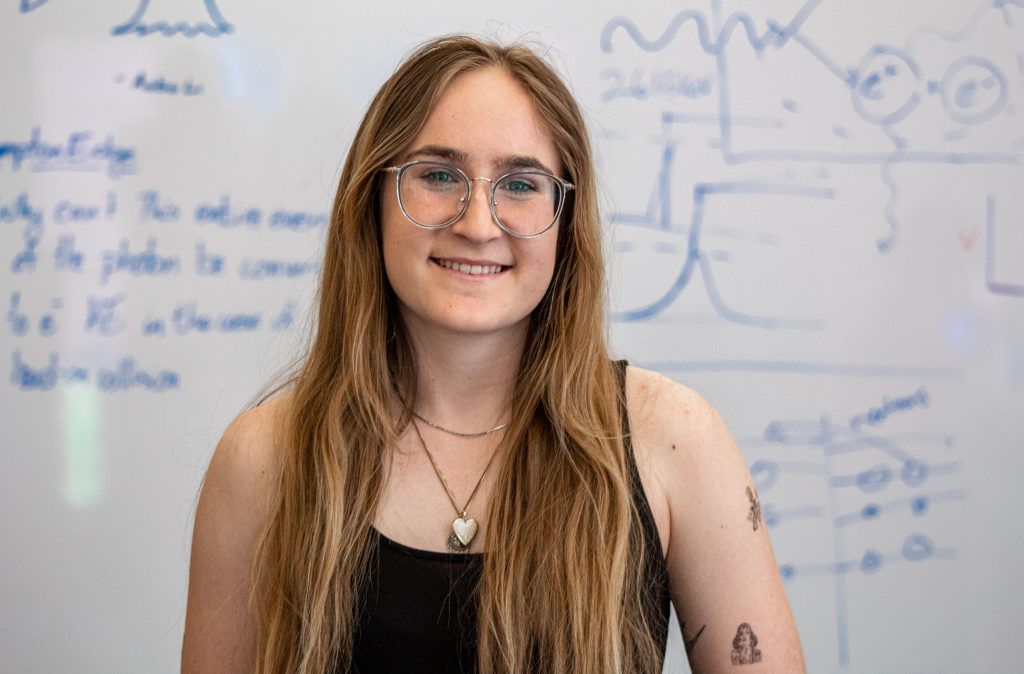In advance of the Celebration of Undergraduate Research on April 26, presented by the Office of Undergraduate Research, we caught up with junior Sarah Vickers, who will be presenting her work as part of the Gruszko lab in the department of physics and astronomy.

When someone asks junior Sarah Vickers about her research in physicist Julieta Gruszko’s lab, she always starts with the same question.
“How much do you know about neutrinos?”
If the mathematics and physics double major were to answer her own question, the colloquial response would be: a lot.
A native of Winchester, Kentucky, Vickers has known physics was her passion since the seventh grade. The first spark came from an episode of PBS’ NOVA that introduced her to black holes, relativity and the space-time continuum.
“‘That’s the coolest thing I’ve ever seen,’” Vickers remembers thinking about the science that led to those discoveries. “‘I’m going to do that.’”
It did not take her long to begin that journey.
At age 15, Vickers began taking STEM courses at Western Kentucky University and, shortly after, began research in an astronomy laboratory on the campus. In the position, she analyzed images taken by telescopes and then coded the data. Though she was grateful for the experience, she sought more involvement.
“I knew I wanted to be more hands on,” she said. “I wanted to build things.”
The opportunity came early in the Tar Heel’s first semester at Carolina. Through a series of cold emails — a tactic Vickers highly recommends to fellow undergraduate researchers — she found a position in the Gruszko lab in the College’s department of physics and astronomy.
In the Gruszko lab, researchers are working to understand why there is significantly more matter than antimatter in the universe by studying neutrinos — miniscule, abundant, neutrally charged particles.
This discrepancy in balance between matter and antimatter is a good thing for us. Had there been an equal amount of the two when the universe was formed, the matter and antimatter would have annihilated each other when colliding, leaving a universe unfit for life as we know it.
But the question remains: Why does this unbalance exist? Vickers calls the subject the “hot topic” in physics.
“The prevailing theory at the moment is that neutrinos are their own antiparticle,” she explains. “This would mean they can oscillate back and forth between those two states.”
To test this theory, Vickers is part of the NuDot project in the Gruszko lab. The team studies neutrinoless double beta decay — the decay of two neutrons into two protons, two electrons and two antineutrinos. If one of those antineutrinos oscillates into a neutrino and collides with the remaining antineutrino, the team would be able to pick up a tiny blip of energy from the collision.
The reward for being the first team to detect this blip is huge: It would answer why there is more matter than anti-matter in the universe.
The thrill of discovery is just one aspect of her research that Vickers loves. Another is how versatile her role is.
In her first assignment, she designed and built electromagnets to act as a magnetic shield for her lab’s detectors, which see light emitted by liquid scintillator. Her design helped to reduce interference that occurs naturally from the Earth’s magnetic field to make data collection as accurate as possible.
“That was a big design project,” she remembers, laughing.
On April 26, Vickers will present her most recent project at UNC’s annual Celebration of Undergraduate Research, presented by the Office of Undergraduate Research.
In this project, she’s been working with her lab mates to test the quality of liquid scintillator — liquid that makes light when a particle hits it — from a company that manufactures it in Austria.
Her poster on these findings will be one of over 300 presentations shared at the celebration. The event, which is hosted in the Blue Zone at Kenan Stadium, is an opportunity for the community to explore the research being conducted across departments at Carolina.
Vickers, an ambassador for the Office of Undergraduate Research and co-president of the Visibility in Physics student organization, presented at last year’s event, too. She is looking forward to another day of sharing her work with her friends and peers. She is also excited to see the research of fellow undergraduate students, some of whom she has mentored through her leadership roles on campus.
“That part, the one-on-one mentoring, is really fun,” she said.
As the December 2023 graduate prepares for her last semester at UNC, she hopes to attend more events that celebrate the cross-collaborative spirit of Carolina.
By Jess Abel ’19, College of Arts and Sciences
Learn more about undergraduate research at Carolina
